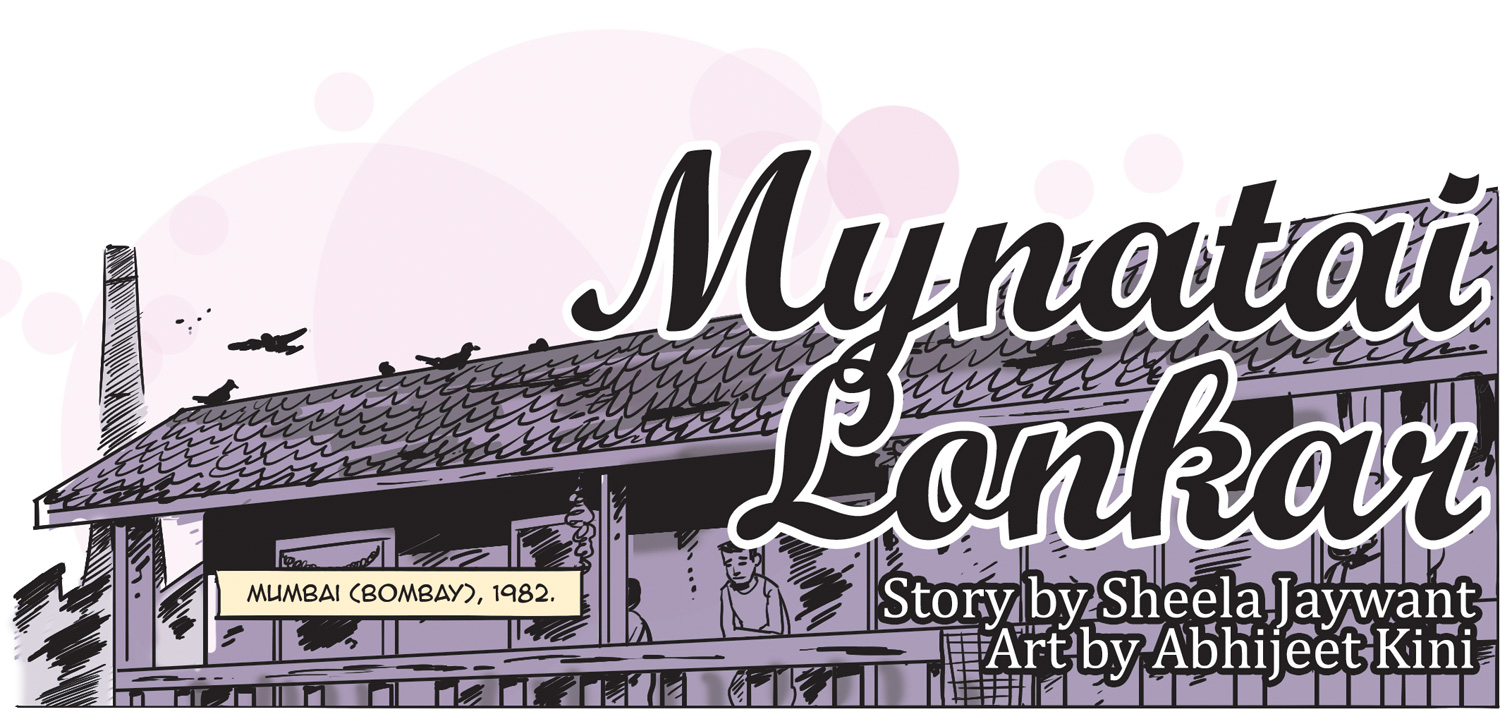
Vol 2 No 3 | Oct-Dec 2022
Mynatai Lonkar
Story by Sheela Jaywant | Art by Abhijeet Kini
For over 150 years, Bombay was known for her wealth. Her riches passed through her busy port and natural harbour, true, but it was generated largely by several cotton textile mills. The ‘girnis’ as the mills were called, stood mainly in Parel, Lalbaug, Worli and Byculla, with a few scattered near Mahim and Dadar.
The millworkers who created that enormous wealth, were migrants from the Konkan coast. They drew fellow villagers, siblings, cousins and other relatives to the city to earn their livelihoods. They lived in chawls and duly sent ‘back home’ money orders after they got their salaries.
The mills covered nearly 600 acres of land in Bombay. The chawls were within walking distance from the mills. So were hospitals, bazars and schools. Close to six generations of workers were born, raised and settled in these localities, where they celebrated festivals, participated in cultural and sports’ activities, and got trained on contemporary machines.
Mills in Mumbai – Historic Textile Mills Of Then Called Bombay (mumbai77.com)
Why cotton textile industries rapidly expanded in Mumbai? – GeeksforGeeks
The workforce was from rural Maharashtra, literate or semi-literate, loyal, committed, and with a zest for learning and doing things right. They were happy to work in the ‘girnis’ as the mills were called. From that word comes the name ‘Girangaon’, which means a gaon or village of mills. Men joined mills when they were young, sometimes sixteen years old, and stayed in the same job until they retired approximately forty years later. Changing jobs was unheard of. Being fired from a job was also not common, unless one had done something very wrong. The lives the mill workers led were exemplary of community living, with its strong sense of belonging and teamwork, its squabbles, romances and cruelties.
Chawls of Bombay—An Introduction | Sahapedia
The architecture of the mills and the chawls reflected the lifestyle and work culture. Sirens punctuated the day, indicating changes in shifts. The chawls were dwellings that had long, wide corridors on either side of a central staircase. On one side were rooms, partitioned into kitchens and sleeping or sitting areas. On the other side were grills that let in breeze and allowed people to see what was happening on the pavement below or across the street. Shared toilets were located at the end of the corridors.
It was in the 1980s that the downfall of the mills began. Politics played a role as did greed. Caring union leaders and educated workers were aware of their rights. The owners of the properties wanted to put their land and buildings to other use.
Textile Industry in Mumbai & It’s Downfall | MeMumbai
The mills closed. An entire lifestyle perished. Very quickly, Bombay changed. Violence raised its head as unemployed young men found outlets for their energy.
City of Gold (2010 film) – Wikipedia
Lalbaug Parel: Zali Mumbai Sonyachi (Marathi) Movie Full Download
The resilient workers, though, gathered their wits and started life from scratch. The men learnt to drive, did sundry skilled jobs, transported and sold vegetables; the women tucked in their sari-padars and hawked home-made pickles, papads, ladoos and other sweets and savouries. Vada-paav and zhunka-bhakar were popularised as was the sandwich-toast. The traditional gave way to more popular food and today, in Girangaon one finds Chinese chow-mein served alongside the rustic kombdi-wada.
Bombay Masala Toast Sandwich Recipe | Veg Recipes of India | Parel Road | Mumbai Street Food
Paneer cheese Franky | Krishna Snacks | Lower Parel | Street Food of Mumbai | Ek Plate Mumbai | Ep32
Breakfast at Ladu Samrat, Lalbaug Parel | Best Batata Vada in Mumbai | Food vlog
Tea-making | Chai | Parel Road | Mumbai Street Food | Food & Travel TV
The mills have mostly gone. In their place stand tall, grand buildings. Outside their gated drives, still bustling and working hard, are the inheritors of the proud legacy of working hard and honestly for a living, no matter what the circumstances.
This story is based on two families. One, of Mynatai Lonkar, who worked in a creche in one of the mills; her husband, Dada, was active in its Union. The second family’s main earning member lost his job one morning, when he was ‘locked-out’ of his factory. He and his wife had no plan. For survival, they made non-perishable food items at home, and sold them in offices, also to housewives. It took two decades for them to now claim that their business is flourishing.

